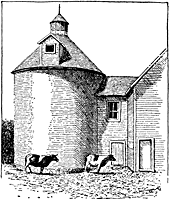|
Main Page
Historic
Narrative
Historic
Agricultural
Census
Maps
& Photos
Barn
Photos
Resources Return to Vermont
Barn Census 2009
 |
|
470
Chase Road, Brownington, Vermont

Brownington, Vermont is a quiet town in the midst of an area
known as the Northeast Kingdom, which is a very remote, rural and
picturesque region of the Green Mountain State. The landscape sways
over rolling hills, and leads into dense woodland. It has had long life
as an agricultural hub for goods and crops, primarily wool, maple
sugar, dairy products, and, surprisingly, the production of hops. Dairy
production would only start picking up later, as the staple Vermont
good, towards the early 1900's. To understand this dynamic past,
historians and
preservationists are working today to inventory these historic
reminants and understand the larger historic scene that they were part
of. Concious examples of that understanding are
visable through the activities of the Old Stone House Museum in
Brownington, as well as through the Orleans County Historical Society. The work comprised here is of a
'windshield-survey' of this town for the Vermont Division of Historic
Preservation,
in collaboration with the University of Vermont's
Graduate Program.
This project included taking
photographs of historic barn structures visible along publically
accessible roads in the town of Brownington. This was done in order to
inventory structures, for further/future research, through the Vermont
Barn Census. In addition, the University of Vermont's Graduate Program
has brought to you this web showcasing, a historic narrative, photo
research, and detailed mapping of the sites currently found.
Telling
the story of this area, through these
remaining historic structures and through research, are essential
elements to
fully rendering the story of what has transpired over this landscape
and how that involved the people who once occupied it. This preliminary
research will help in telling a
portion of the communities past. However, more detailed histories for
these
buildings is
still necessary, through the help of property owners,
historians, and local volunteers. 
|



